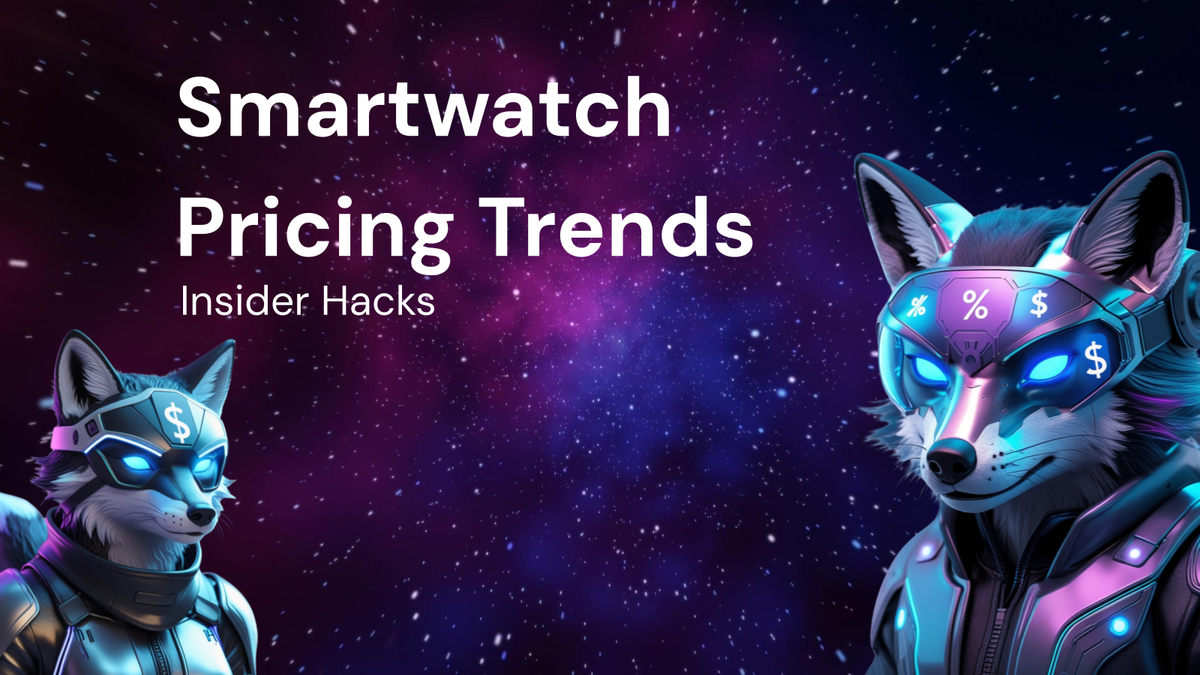Insider Hacks to Uncover Smartwatch Pricing Trends

Insider Hacks to Uncover Smartwatch Pricing Trends: Decode the Market and Snag the Best Deals
The smartwatch market is a dynamic landscape, constantly evolving with new technologies, designs, and functionalities. Navigating this landscape, especially when trying to find the best deals, can feel overwhelming. Price fluctuations are common, influenced by factors ranging from component costs to marketing strategies. Understanding these price trends is crucial for making informed purchasing decisions and avoiding overpaying for your desired smartwatch.
This comprehensive guide unveils insider hacks and strategies to effectively analyze smartwatch pricing trends, empowering you to become a savvy shopper and secure the best possible value. We'll delve into the key factors driving price changes, explore valuable tools and resources, and arm you with actionable tips to predict price drops and optimize your buying time.
I. Understanding the Foundations: Factors Driving Smartwatch Pricing
Before diving into specific hacks, it's essential to understand the fundamental forces that shape smartwatch pricing. By grasping these underlying factors, you'll be better equipped to anticipate price movements and make more informed predictions.
- Technological Advancements: The relentless pace of technological innovation is a major driver of smartwatch pricing. New features, such as advanced health tracking sensors (ECG, SpO2), improved processors, brighter displays, and longer battery life, often command premium prices. As these technologies mature and become more accessible, their prices tend to decrease over time. For instance, when a new generation of sensors is introduced, the previous generation might see price reductions.
- Component Costs: The cost of components, including processors, displays, sensors, batteries, and memory, directly impacts the manufacturing cost of smartwatches. Fluctuations in the prices of these components, often driven by supply chain dynamics and global economic conditions, can influence the final retail price. For example, a shortage of a specific type of display panel could lead to price increases for smartwatches that use it.
- Brand and Marketing: Brand reputation and marketing strategies play a significant role in establishing a smartwatch's price point. Established brands with strong brand recognition and extensive marketing campaigns often command higher prices than lesser-known brands, even if the underlying technology is comparable. The perceived value associated with a particular brand contributes to its pricing power. Premium brands often employ marketing tactics that justify higher prices, such as celebrity endorsements and exclusive partnerships.
- Competition: The smartwatch market is becoming increasingly competitive, with numerous manufacturers vying for market share. Intense competition can lead to price wars and promotional discounts as companies try to attract customers. The entry of new players with competitive offerings often puts pressure on existing brands to adjust their prices.
- Currency Exchange Rates: For international brands and retailers, currency exchange rates can impact the cost of importing components and selling products in different markets. Fluctuations in exchange rates can lead to price adjustments to maintain profit margins. A strong dollar, for example, might lead to lower prices for imported smartwatches in the US market.
- Supply and Demand: Like any product, the principles of supply and demand influence smartwatch pricing. High demand and limited supply can drive prices up, while low demand and ample supply can lead to price reductions. Seasonal factors, such as holidays and gift-giving occasions, can significantly impact demand and, consequently, prices.
- Retailer Margins: Retailers also play a role in determining the final price of a smartwatch. Different retailers have different operating costs and profit margins, which can influence the price they charge. Online retailers often have lower overhead costs than brick-and-mortar stores, allowing them to offer more competitive prices.
- Product Lifecycle: A smartwatch's price typically follows a predictable lifecycle. It's launched at a premium price, gradually declines over time as newer models are introduced, and eventually reaches its lowest price point before being discontinued. Understanding this lifecycle can help you time your purchase for optimal savings.
II. Insider Hacks for Uncovering Smartwatch Pricing Trends
Now that you have a solid understanding of the underlying factors, let's explore the specific hacks you can use to uncover and analyze smartwatch pricing trends.
- Price Tracking Websites and Apps:
- CamelCamelCamel (Amazon Specific): This website is invaluable for tracking Amazon prices. Simply paste the Amazon product URL, and CamelCamelCamel will display a historical price chart, showing the highest, lowest, and average prices over time. You can also set up price alerts to receive notifications when the price drops below your desired threshold.
- Keepa (Amazon Specific): Similar to CamelCamelCamel, Keepa provides comprehensive price tracking for Amazon products. It offers detailed price history charts, price drop alerts, and browser extensions for seamless integration with Amazon.
- PriceRunner & PriceSpy (Broader Comparison): These websites allow you to compare prices from multiple retailers, not just Amazon. They provide price history charts and price alerts, helping you identify the best deals across different platforms.
- Google Shopping (Aggregated Comparison): Google Shopping is a powerful tool for comparing prices from a wide range of retailers. It allows you to filter results by price, brand, features, and retailer.
- Utilize Price History Charts:
- Analyze Historical Data: Once you've identified a price tracking tool, carefully analyze the price history chart for your desired smartwatch. Look for patterns, such as seasonal price drops, consistent price declines, or temporary price spikes. This historical data provides valuable insights into how the price might behave in the future.
- Identify Seasonal Trends: Smartwatch prices often fluctuate based on seasonal events. For example, you might see price drops during Black Friday, Cyber Monday, Christmas, and back-to-school sales. Identifying these trends allows you to anticipate future price drops and plan your purchase accordingly.
- Look for Consistent Declines: If the price history chart shows a consistent downward trend, it suggests that the smartwatch is likely to continue declining in price. This is especially true for older models that are nearing the end of their product lifecycle.
- Follow Social Media and Online Forums:
- Deals Communities: Platforms like Slickdeals, Reddit's r/deals and r/smartwatches, and DealNews are excellent sources for discovering current deals and promotions on smartwatches. Members of these communities often share information about price drops, coupon codes, and other money-saving opportunities.
- Manufacturer and Retailer Accounts: Follow the social media accounts of smartwatch manufacturers and retailers. They often announce upcoming sales, promotions, and new product releases on these platforms.
- Tech Blogs and Review Sites: Tech blogs and review sites often publish articles about smartwatch pricing trends and deals. Stay informed by subscribing to their newsletters and regularly checking their websites.
- Leverage Email Newsletters and Alerts:
- Retailer Newsletters: Sign up for email newsletters from major retailers like Amazon, Best Buy, and Walmart. These newsletters often contain exclusive deals and promotions that are not advertised elsewhere.
- Price Alert Services: Set up price alerts on price tracking websites and apps to receive notifications when the price of your desired smartwatch drops below a certain threshold. This ensures that you don't miss out on potential savings.
- Monitor Refurbished and Open-Box Options:
- Certified Refurbished: Consider purchasing a certified refurbished smartwatch directly from the manufacturer or a reputable retailer. These devices have been thoroughly tested and restored to like-new condition, often with a warranty.
- Open-Box Items: Open-box items are products that have been returned by previous customers. They are typically in excellent condition and come with a discount. Check the retailer's return policy before purchasing an open-box item.
- Negotiate Prices (Where Possible):
- Brick-and-Mortar Stores: Don't be afraid to negotiate prices at brick-and-mortar stores, especially if you're buying multiple items or paying in cash. Sales associates often have some flexibility to lower the price, especially if they're trying to clear out inventory.
- Online Chat: Some online retailers offer live chat support. Use this feature to inquire about potential discounts or promotions.
- Take Advantage of Trade-In Programs:
- Manufacturer and Retailer Trade-Ins: Many manufacturers and retailers offer trade-in programs that allow you to exchange your old smartwatch for a discount on a new one. This can be a great way to save money and recycle your old device. Apple, Samsung, and Best Buy frequently offer trade-in programs.
- Factor in Total Cost of Ownership:
- Accessories and Subscriptions: When comparing smartwatch prices, don't forget to factor in the total cost of ownership. This includes the cost of accessories like charging docks, screen protectors, and replacement bands, as well as any subscription fees for premium features or services.
III. Timing Your Purchase for Optimal Savings
Knowing when to buy is just as important as knowing where to buy. Certain times of the year are more conducive to finding the best deals on smartwatches.
- Black Friday and Cyber Monday: These are the biggest shopping events of the year, offering significant discounts on a wide range of products, including smartwatches. Be prepared to act quickly, as deals often sell out fast.
- Christmas and Holiday Season: Retailers often offer special promotions and discounts during the Christmas and holiday season to attract shoppers.
- Back-to-School Sales: Many retailers offer back-to-school sales in late summer, which can include discounts on smartwatches.
- New Product Releases: When a new smartwatch model is released, the prices of older models typically decline. This is a great opportunity to snag a discounted price on a still-capable device.
- Amazon Prime Day: Amazon Prime Day is an annual shopping event exclusively for Prime members, offering substantial discounts on a wide variety of products.
- End of Quarter/Year Sales: Retailers often try to clear out inventory at the end of each quarter and year, leading to potential discounts.
IV. Staying Ahead of the Curve: Future Trends in Smartwatch Pricing
The smartwatch market is constantly evolving, and staying ahead of the curve requires monitoring emerging trends and technologies.
- Increased Integration of AI and Machine Learning: Future smartwatches are likely to incorporate more advanced AI and machine learning capabilities, such as personalized health recommendations and proactive health alerts. This could lead to price increases for premium models.
- Focus on Health and Wellness: The trend towards health and wellness tracking is expected to continue, with future smartwatches incorporating more sophisticated sensors and features. This could also drive up prices, particularly for models with advanced health monitoring capabilities.
- Expansion of 5G Connectivity: As 5G networks become more widespread, future smartwatches may offer faster and more reliable connectivity, enabling new applications and services. This could lead to price premiums for 5G-enabled models.
- Growth of Foldable and Flexible Displays: Foldable and flexible displays are emerging technologies that could revolutionize the smartwatch market. However, these technologies are currently expensive, and their adoption could lead to higher prices for smartwatches with these features.
V. Conclusion: Become a Smart Smartwatch Shopper
Uncovering smartwatch pricing trends requires a combination of research, analysis, and strategic planning. By understanding the underlying factors that influence prices, utilizing price tracking tools, monitoring social media and online forums, and timing your purchase strategically, you can become a savvy shopper and secure the best possible value for your desired smartwatch. Remember to factor in the total cost of ownership, consider refurbished and open-box options, and negotiate prices whenever possible. By following these insider hacks, you'll be well-equipped to navigate the dynamic smartwatch market and make informed purchasing decisions that save you money. So, go forth, do your research, and snag that smartwatch deal you've been waiting for! Good luck!




